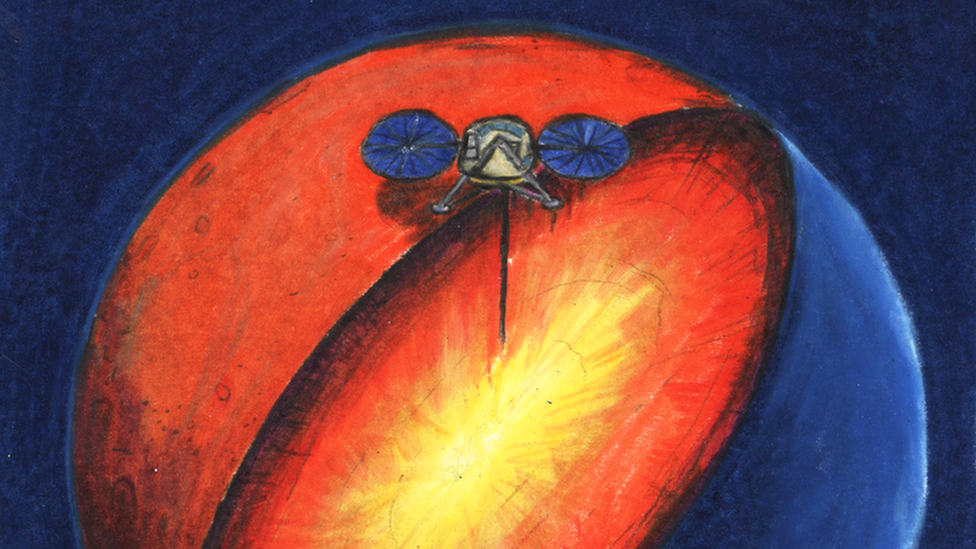InSight Diary: The silence of space
- Published
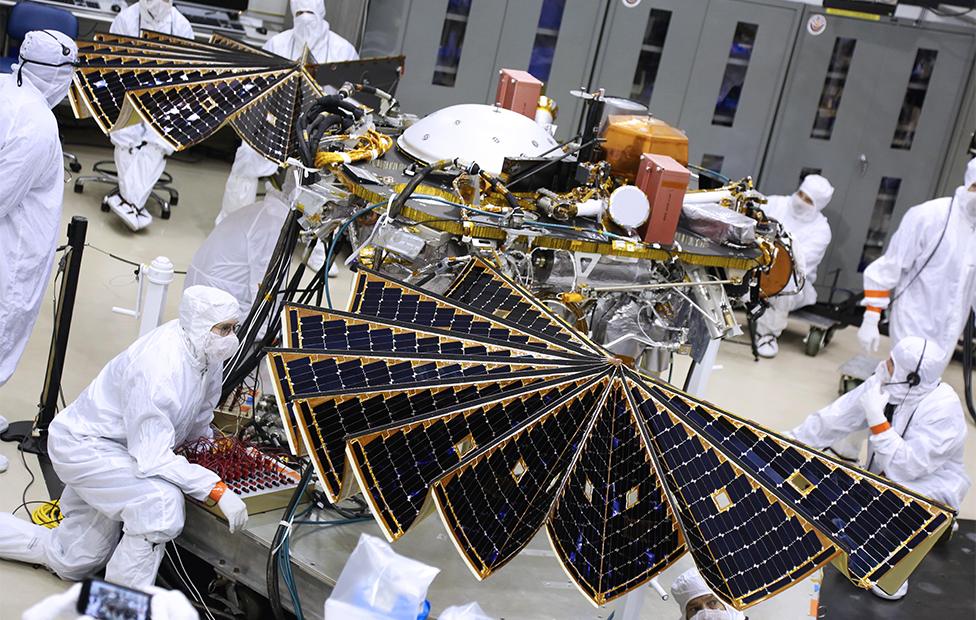
The InSight probe is set to touch down on the surface of Mars on Monday
Prof Tom Pike from Imperial College London is part of the science team on the US-led InSight mission to Mars, external. His group has supplied tiny seismometers, external that will enable the Nasa lander to detect "Marsquakes", which should reveal the internal structure of the Red Planet. Here, Prof Pike tells us what happened when his team switched on its sensor system during InSight's 6-month cruise to Mars.
InSight is now just two days from Mars, closing in at more than 6,000mph. But it's not breaking a sweat.
After May's launch hurled it towards Mars, InSight has been quietly following an orbit around the Sun, an orbit selected to catch up with Mars on Monday evening (UK time).
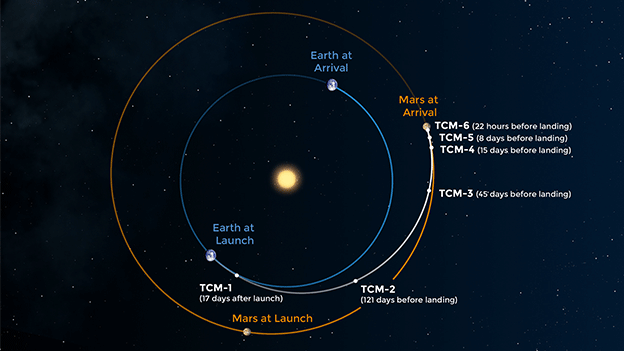
Almost there: InSight launched from Earth on 5 May. It lands on Monday
On board, we have our silicon microseismometers, designed to pick up the faintest seismic activity once we land on Mars.
Our spacecraft should be one of the quietest objects in the entire Solar System, a perfect zero gravity environment.
We always wanted to turn on our microseismometers during our cruise to Mars for what should be the best possible test of their sensitivity. That's difficult to do on Earth.
Even when we took our microseismometers to one of the quietest places in Europe, deep in a mine under the Black Forest Mountains in Germany, the strongest signal came from the sea, hundreds of miles away. That signal was much larger than we're likely to see from any Marsquakes.
Did we survive launch?
So, on our way we've decided to turn on our microseismometers for a few hours. It's not obvious what we will hear - nobody has measured the vibrations of an interplanetary spacecraft before with this sensitivity. We hope it's not the creaks and groans of the spacecraft itself, as it should have settled down after the launch.
There will be the occasional ping from interplanetary dust hitting the spacecraft, but we've calculated the chance of that happening while we're turned on is remote.
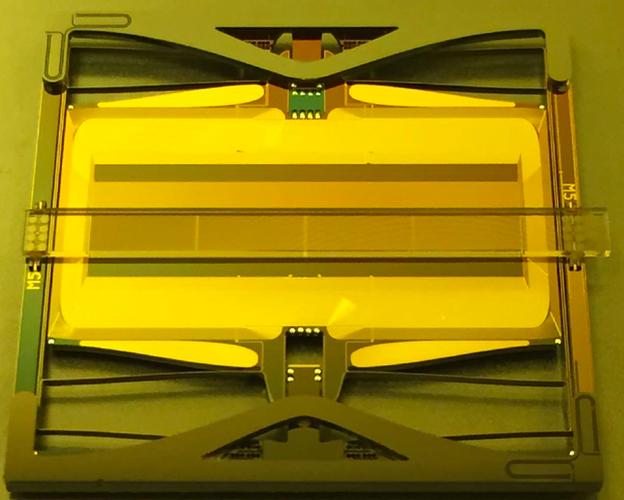
One of the microseismometer sensors, carved from a single piece of silicon 25mm square
There's not been a sensor quite like ours sent into space before - the silicon mass and spring are designed to move freely backwards and forwards during launch and would have been bumped repeatedly between our solder stops.
Of course, we tested this, but I'm now wondering if it was such a good idea to be the first to try something this new.
We've three sensors, one to measure the vertical seismic vibrations on Mars, SP1, and two to measure in the horizontal directions, SP2 and SP3.
Only SP2 and SP3 will work in the zero gravity of space. SP1 will be pushed to the stops by its silicon springs designed for Mars.
As the first snippets of data come down, we look immediately at the voltages of the three outputs - if the sensors have survived and are operational, they should be close to zero. SP1 is high, but that's as expected. SP2 and SP3 show low voltages - they're working! But how well?
The team, Constantinos, Alex, John and Zac, get down to analysing the full data.
First we realise just how quiet our spacecraft is. All we are detecting on both our operational sensors is a very gentle background vibration.
If we play this signal speeded up on our headphones, it's an almost imperceptible hiss.
This signal is being created by the microseismometers themselves - in space, our sensors can be heard for the first time, without the interference from any oceans.
Even better, this signal from the sensors themselves is very low, less than one billionth of the gravitational acceleration on the surface of Earth, 1g.
Our accelerometers are not only working, they're working as well as we could have possibly expected.
Bumps in the night
But as we look further at the data, we see something else - there appear to be tiny jolts, every half hour or so, about a millionth of 1g. That's still one thousand times the noise from the sensors.
The jolts are seen at the same time on both SP2 and SP3, so are unlikely to be from the sensors themselves. That is certainly a relief. Could they be dust impacts?
We double check - the jolts are far too large, even if we were going right through a comet's tail. We're starting to think it must be the spacecraft itself.
The microseismometers picked up vibrations on the cruise to Mars, but what were they?
The sound from two of the microseismometers on the way to Mars, speeded up 1,000 times. The background hiss is the noise from the sensors themselves, and the chirps are the thrusters of the spacecraft as it keeps the solar arrays pointing at the Sun.

We're travelling on a twin of the Phoenix spacecraft that delivered another lander to Mars for Nasa 10 years ago.
I know the mission well - I'd worked on the microscope station on the Phoenix lander - but had never paid much attention as to how we got to Mars.
Going through the papers, we find the Phoenix spacecraft used thrusters firing for a fraction of a second, to nudge its solar arrays to look straight at the Sun.
Although too small to see with the instruments on Phoenix, our microseismometers on InSight should be able to detect these nudges. All we need now is confirmation from the spacecraft team of when the thrusters fired.
As dawn breaks on the States, we get back a list of the firing times.
They match perfectly with the jolts we're seeing on the microseismometers. It's an unanticipated test of our sensors, and of the Imperial team.
It's been extremely valuable to be able to test our microseismometers in space.
Although landing is the riskiest part of our journey, we know they've survived the launch in perfect condition. Now there is just the small matter of getting down onto the surface of Mars in one piece.
- Published7 May 2018
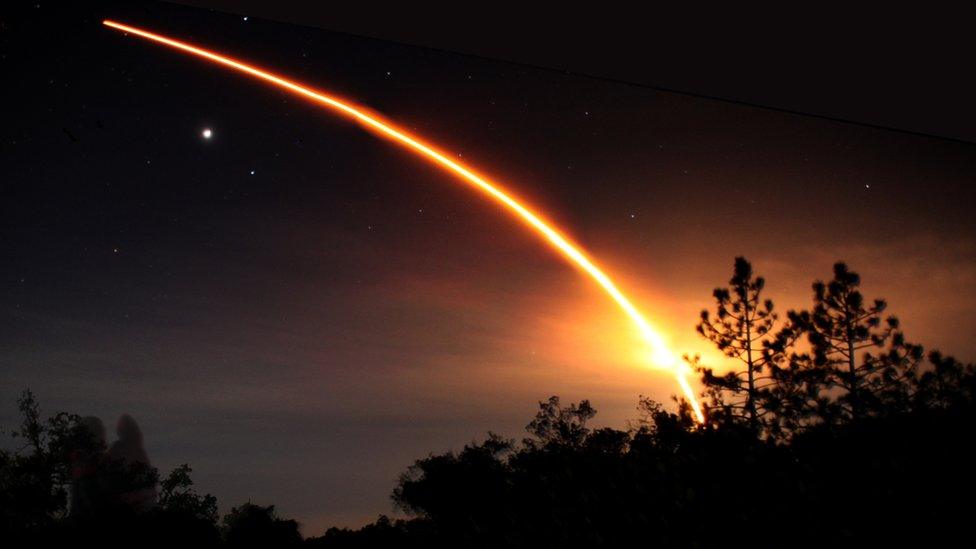
- Published1 May 2018
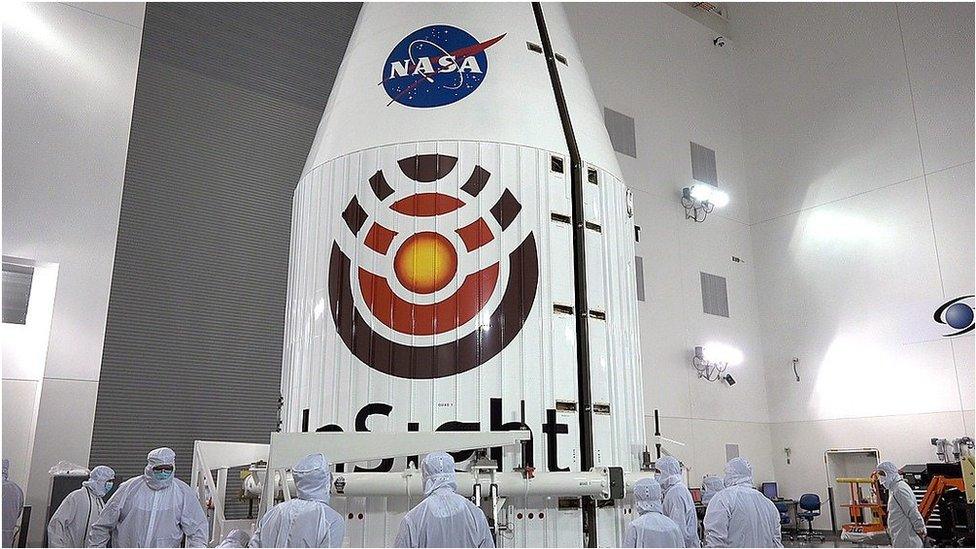
- Published5 May 2018
